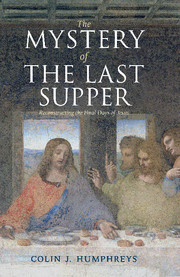Book contents
- Frontmatter
- Contents
- List of illustrations
- Foreword by I. Howard Marshall
- Acknowledgements
- 1 Four mysteries of the last week of Jesus
- 2 Dating the crucifixion – the first clues
- 3 The problem of the last supper
- 4 Can we reconstruct the Jewish calendar at the time of Christ?
- 5 The date of the crucifixion
- 6 The moon will be turned to blood
- 7 Did Jesus use the solar calendar of Qumran for his last supper Passover?
- 8 Does ancient Egypt hold a key to unlocking the problem of the last supper?
- 9 Discovering the lost calendar of ancient Israel
- 10 Was the lost ancient Jewish calendar used in Israel at the time of Jesus?
- 11 The date of the last supper: the hidden clues in the gospels
- 12 From the last supper to the crucifixion: a new analysis of the gospel accounts
- 13 A new reconstruction of the final days of Jesus
- Notes
- Bibliography
- Index of biblical and other ancient sources
- General index
Foreword by I. Howard Marshall
Published online by Cambridge University Press: 03 May 2011
- Frontmatter
- Contents
- List of illustrations
- Foreword by I. Howard Marshall
- Acknowledgements
- 1 Four mysteries of the last week of Jesus
- 2 Dating the crucifixion – the first clues
- 3 The problem of the last supper
- 4 Can we reconstruct the Jewish calendar at the time of Christ?
- 5 The date of the crucifixion
- 6 The moon will be turned to blood
- 7 Did Jesus use the solar calendar of Qumran for his last supper Passover?
- 8 Does ancient Egypt hold a key to unlocking the problem of the last supper?
- 9 Discovering the lost calendar of ancient Israel
- 10 Was the lost ancient Jewish calendar used in Israel at the time of Jesus?
- 11 The date of the last supper: the hidden clues in the gospels
- 12 From the last supper to the crucifixion: a new analysis of the gospel accounts
- 13 A new reconstruction of the final days of Jesus
- Notes
- Bibliography
- Index of biblical and other ancient sources
- General index
Summary
For the past few years I have been following with keen interest and excitement the researches of Colin Humphreys into the last supper narratives in the gospels. Previously he had investigated the exodus of the Israelites from Egypt and the ten unusual happenings recorded as accompanying that event. He also offered a new identification of the ‘star of Bethlehem’ as a comet that appeared in 5 bc. Finally, he made a fresh attempt to date the crucifixion of Jesus by using astronomical evidence for determining the likely year and also by proposing that Peter's reference in his Pentecost speech to the moon being turned to blood (Acts 2:20) was to a lunar eclipse in ad 33 at which the moon would indeed have had a blood-red appearance.
This new book returns to this last theme and offers a detailed study of the associated puzzles caused by the apparent discrepancy between the gospel of John and the other three gospels on the date of the last supper of Jesus. Colin's solution is a new version of the old theory that different Jewish groups may have used different calendrical systems, together with a proposal that Jesus held his meal not on the Thursday immediately preceding his crucifixion on the Friday but on the Wednesday evening, a view that allows a more adequate period of time for all the recorded events that have to be fitted in between the meal and the crucifixion.
- Type
- Chapter
- Information
- The Mystery of the Last SupperReconstructing the Final Days of Jesus, pp. ix - xiPublisher: Cambridge University PressPrint publication year: 2011

